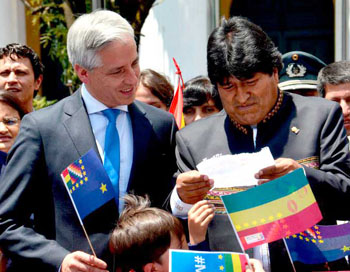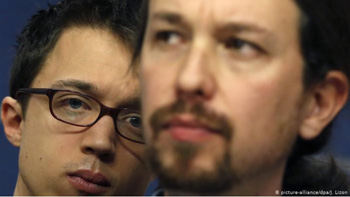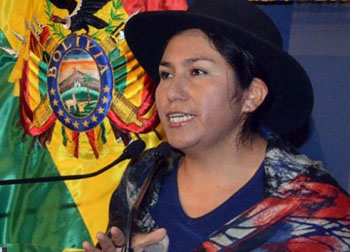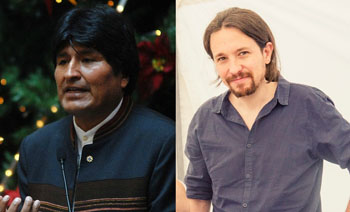International Affairs
 |
 |
 |
 |
 |
 |
 |
Making America Socialist - Part III
Same Leftist Strategy Makes Morales
President of Bolivia
In the past two installments of this series, I looked at Communism’s goal of conquering the Americas, and how it was quite successful in Venezuela (here and
here). In this installment, I will look at how Communism rose to power in Bolivia.
I will particularly look at the ideology, communications strategy, & financial approach used by Evo Morales, the country’s disgraced former president who, after being caught in election fraud last year, had to flee to Mexico and then Argentina seeking political asylum.
Ideology
In fact, Evo Morales is not the real brains behind his rise to power. Morales has not written any ideological work, his only work is his autobiography, My Life, from Orinoca to the Palacio Quemado (Mi Vida de Orinoca al Palacio Quemado).
 The real intellectual force behind Evo Morales’ successful rise to power is Álvaro García Linera, former leader of the Túpac Katari Guerrilla Army (an indigenist Marxist terrorist group). He was arrested under charges of an armed uprising; notwithstanding, he later became Vice President in Evo Morales’ regime. An example of how corruption in Bolivia walks hand in hand with Communism.
The real intellectual force behind Evo Morales’ successful rise to power is Álvaro García Linera, former leader of the Túpac Katari Guerrilla Army (an indigenist Marxist terrorist group). He was arrested under charges of an armed uprising; notwithstanding, he later became Vice President in Evo Morales’ regime. An example of how corruption in Bolivia walks hand in hand with Communism.
According to an article in the Argentinian magazine Anfibia (an organ of the University of San Martín, Buenos Aires), “The co-pilot of Evo Morales is, in his turn, one of the most original political theorists in the region". He is "the classic Marxist" who defied his past and became a ruling intellectual.
In the same magazine, Pablo Stefanoni explains how Linera, after doing jail time, “cleaned up” his terrorist image and became a “respectable” intellectual before assuming office:
 “After his release from prison in 1997, García Linera tried his luck with university work while on parole. At the same time, he began to assume a role in the media: First, very modestly, on the university channel, then, as a panelist on the El Pentagon program, which has a strong influence among public opinion makers." From there, he went on to have a television voice and became a mentor for Morales.
“After his release from prison in 1997, García Linera tried his luck with university work while on parole. At the same time, he began to assume a role in the media: First, very modestly, on the university channel, then, as a panelist on the El Pentagon program, which has a strong influence among public opinion makers." From there, he went on to have a television voice and became a mentor for Morales.
"At the same time, along with several others, García Linera formed the group Comuna, which began to organize debates and to publish a series of 'urgent works.'
"By that time, this mix of university professor and sophisticated media analyst had given García Linera a new air of respectability that partly erased the terrorist label that had kept him locked down."
With his unsavory past tidied up, García Linera could better spread Communism in a more “palatable” way. The Comuna group he founded was made up of like-minded Marxist intellectuals dedicated to political debate and spreading communist propaganda.
What were the goals of this new group? According to Stefanoni, “Comuna's goal was clear: to carry out a theoretical-political exercise that could take advantage of the changes in Bolivian society that had caused ... the emergence of types of collective action that challenged political and social analysis ... whose politics were leftist. …
“The Spanish contribution to this process came from two of the founders of Podemos, Alfredo Serrano and Íñigo Errejón. The book they wrote Ahora es Cuándo …: Del asalto a la transformación del Estado de Bolivia (Now is the time …: From assault to the transformation of the State of Bolivia) traces the strategic line that the pro-cocaine MAS (Movimiento Al Socialismo – Movement toward Socialism) party followed to the letter, with that party serving as a political platform for Evo Morales in his conquest of power.”
Strategy of Conquest: Re-structuring power
As explained in my two previous articles, the way communists were able to achieve structural transformation in Venezuela and Ecuador was by modifying each nation’s Constituent Assembly and changing the Constitution to favor their goals. This also took place in Bolivia under Evo Morales.
 According to
an analysis by Podemos member Íñigo Errejón, “The demand to call a Constituent Assembly became the final tool used to undertake a structural transformation of the State. When in December 2005 Evo Morales and the Movimiento Al Socialismo (MAS) won in the presidential elections by a historic 54% of the popular vote, they had taken up the main demands of the social movements and the indigenous organizations as their political program. In addition to demands for nationalization, the green cause and agrarian reform, there was the call for a Constituent Assembly to 're-found Bolivia.'"
According to
an analysis by Podemos member Íñigo Errejón, “The demand to call a Constituent Assembly became the final tool used to undertake a structural transformation of the State. When in December 2005 Evo Morales and the Movimiento Al Socialismo (MAS) won in the presidential elections by a historic 54% of the popular vote, they had taken up the main demands of the social movements and the indigenous organizations as their political program. In addition to demands for nationalization, the green cause and agrarian reform, there was the call for a Constituent Assembly to 're-found Bolivia.'"
It did not take long after changing the Constituent Assembly for changes to be made to the Bolivian Constitution. Indeed, according to El Universo, the Constitution was changed nine months later: “On July 2, 2006, the elections for Constituent Assembly members were held, where the 255 members of the Constituent Assembly charged with drafting a new Constitution and deciding on the matter of regional autonomies in that new Constitution were elected. …
“Finally, the New Political Constitution of the State was organically approved on December 10, 2007, in the city of Oruro, by 164 of the 255 constituent assembly members.”
Communication strategy
Prof. Olga Dragnic affirmed that the purpose of media in a socialist society is to maintain social control: "The media must provide knowledge about the social and political reality that citizens require for their active and conscious insertion in the structures of participation and social control. The creation of ways for the media to assume social control takes place within the framework of the absolute validity of freedom of expression and the right to information. ”
 This was precisely the idea of Evo Morales when he created the Ministry of Communication, a governmental organ dedicated to controlling information given to the public to “liberate” them: "We are replacing this Ministry (of Communication) because, after more than five years of government, I realized that communication is important for information and education and to liberate the Bolivian people," said the indigenous leader.
This was precisely the idea of Evo Morales when he created the Ministry of Communication, a governmental organ dedicated to controlling information given to the public to “liberate” them: "We are replacing this Ministry (of Communication) because, after more than five years of government, I realized that communication is important for information and education and to liberate the Bolivian people," said the indigenous leader.
Morales’ also relied on massive help from Spain in this communication strategy: He paid his socialist friends at Podemos (the Spanish extreme-leftist party) over 1 million euros to create propaganda for Bolivia. According to PR Noticias, the consulting firm Neurona, closely linked to the leftist Podemos, the party of Pablo Iglesias, received 1.3 million euros between 2017 and 2018 for making 169 short videos for the government of Evo Morales, as published by El Mundo newspaper.
Financing the Revolution
How was Morales’ able to fund this new socialist regime in Bolivia? With dirty money, in particular, drug trafficking cash. Journalist Jaime Bayly says that Morales supplied Mexico with cocaine in return for funds. In an article in El Español, he affirmed, “In total, Mexicans must have paid $250 million dollars a year to the Government of Evo Morales, of which he kept a quarter."
 "Evo put $5 million a month in his pocket," Bayly continues. "Surely he gave Pablo Iglesias two or three million," adding that the former president went on to tell party insiders that he was going "to reconquer Spain with the help of Iglesias and cocaine."
"Evo put $5 million a month in his pocket," Bayly continues. "Surely he gave Pablo Iglesias two or three million," adding that the former president went on to tell party insiders that he was going "to reconquer Spain with the help of Iglesias and cocaine."
Morales’ financial and communication strategies present a triple quid pro quo: Morales supplies cocaine to Mexico, who in turn gives Morales piles of money. Morales then uses this drug money to support Podemos in Spain, which in its turn supports Morales by creating communist propaganda for him.
What is ironic is that these socialists always speak about fighting corruption...
Continued

I will particularly look at the ideology, communications strategy, & financial approach used by Evo Morales, the country’s disgraced former president who, after being caught in election fraud last year, had to flee to Mexico and then Argentina seeking political asylum.
Ideology
In fact, Evo Morales is not the real brains behind his rise to power. Morales has not written any ideological work, his only work is his autobiography, My Life, from Orinoca to the Palacio Quemado (Mi Vida de Orinoca al Palacio Quemado).

Linera, left, the former terrorist & intellectual force bhind Evo's rise to power
According to an article in the Argentinian magazine Anfibia (an organ of the University of San Martín, Buenos Aires), “The co-pilot of Evo Morales is, in his turn, one of the most original political theorists in the region". He is "the classic Marxist" who defied his past and became a ruling intellectual.
In the same magazine, Pablo Stefanoni explains how Linera, after doing jail time, “cleaned up” his terrorist image and became a “respectable” intellectual before assuming office:

Linera & wife rowed by a native for a photo op
"At the same time, along with several others, García Linera formed the group Comuna, which began to organize debates and to publish a series of 'urgent works.'
"By that time, this mix of university professor and sophisticated media analyst had given García Linera a new air of respectability that partly erased the terrorist label that had kept him locked down."
With his unsavory past tidied up, García Linera could better spread Communism in a more “palatable” way. The Comuna group he founded was made up of like-minded Marxist intellectuals dedicated to political debate and spreading communist propaganda.
What were the goals of this new group? According to Stefanoni, “Comuna's goal was clear: to carry out a theoretical-political exercise that could take advantage of the changes in Bolivian society that had caused ... the emergence of types of collective action that challenged political and social analysis ... whose politics were leftist. …
“The Spanish contribution to this process came from two of the founders of Podemos, Alfredo Serrano and Íñigo Errejón. The book they wrote Ahora es Cuándo …: Del asalto a la transformación del Estado de Bolivia (Now is the time …: From assault to the transformation of the State of Bolivia) traces the strategic line that the pro-cocaine MAS (Movimiento Al Socialismo – Movement toward Socialism) party followed to the letter, with that party serving as a political platform for Evo Morales in his conquest of power.”
Strategy of Conquest: Re-structuring power
As explained in my two previous articles, the way communists were able to achieve structural transformation in Venezuela and Ecuador was by modifying each nation’s Constituent Assembly and changing the Constitution to favor their goals. This also took place in Bolivia under Evo Morales.

Inigo Errejon, left, is considered important in Podemos, second only to Pablo Iglesias, right
It did not take long after changing the Constituent Assembly for changes to be made to the Bolivian Constitution. Indeed, according to El Universo, the Constitution was changed nine months later: “On July 2, 2006, the elections for Constituent Assembly members were held, where the 255 members of the Constituent Assembly charged with drafting a new Constitution and deciding on the matter of regional autonomies in that new Constitution were elected. …
“Finally, the New Political Constitution of the State was organically approved on December 10, 2007, in the city of Oruro, by 164 of the 255 constituent assembly members.”
Communication strategy
Prof. Olga Dragnic affirmed that the purpose of media in a socialist society is to maintain social control: "The media must provide knowledge about the social and political reality that citizens require for their active and conscious insertion in the structures of participation and social control. The creation of ways for the media to assume social control takes place within the framework of the absolute validity of freedom of expression and the right to information. ”

Marianela Durán of MAS headed the new Ministry of Communications
Morales’ also relied on massive help from Spain in this communication strategy: He paid his socialist friends at Podemos (the Spanish extreme-leftist party) over 1 million euros to create propaganda for Bolivia. According to PR Noticias, the consulting firm Neurona, closely linked to the leftist Podemos, the party of Pablo Iglesias, received 1.3 million euros between 2017 and 2018 for making 169 short videos for the government of Evo Morales, as published by El Mundo newspaper.
Financing the Revolution
How was Morales’ able to fund this new socialist regime in Bolivia? With dirty money, in particular, drug trafficking cash. Journalist Jaime Bayly says that Morales supplied Mexico with cocaine in return for funds. In an article in El Español, he affirmed, “In total, Mexicans must have paid $250 million dollars a year to the Government of Evo Morales, of which he kept a quarter."

Pablo Iglesias, right, from the Spanish extreme-left Podemos' backed Morales
Morales’ financial and communication strategies present a triple quid pro quo: Morales supplies cocaine to Mexico, who in turn gives Morales piles of money. Morales then uses this drug money to support Podemos in Spain, which in its turn supports Morales by creating communist propaganda for him.
What is ironic is that these socialists always speak about fighting corruption...
Continued

Posted June 15, 2020
______________________
______________________
 Volume I |
 Volume II |
 Volume III |
 Volume IV |
 Volume V |
 Volume VI |
 Volume VII |
 Volume VIII |
 Volume IX |
 Volume X |
 Volume XI |
 Special Edition |


